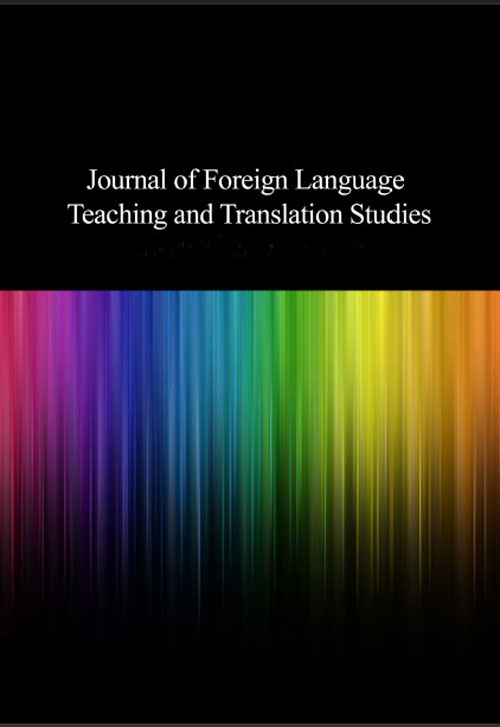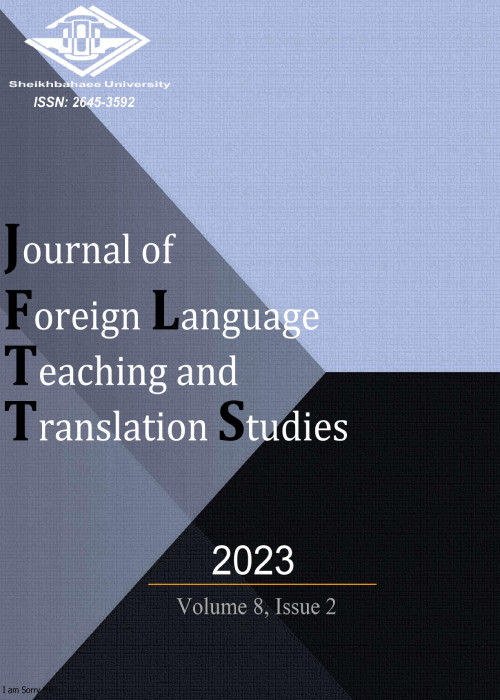فهرست مطالب

Journal of Foreign Language Teaching and Translation Studies
Volume:2 Issue: 2, Summer 2013
- تاریخ انتشار: 1397/03/30
- تعداد عناوین: 5
-
Page 1As building blocks of coherent discourse, lexical bundles, frequent word combinations that commonly occur in different registers, have attracted the attention of researchers in corpus linguistics in the last decade. The importance of these word clusters lies in their often necessary functional contribution to the development of evolving discourse. While most previous studies of bundles have been mainly concerned with variations in the use of these word sequences across different registers (e.g., conversation, classroom teaching, and lectures) and a number of disciplines (e.g., history and biology), postgraduate genres have not been the subject of adequate rigorous analysis. This corpus-based study explored possible differences and\or similarities between two student's genres in terms of the variety, structure, and function of lexical bundles. Through two corpora of master theses and doctoral dissertations in one single discipline of applied linguistics, the study showed that not only was there a large intradisciplinary difference between the two genres in the range of bundles employed, but also there were some striking differences in the total frequency and function of these word combinations. Some implications for academic writing instruction have also been discussed.Keywords: Lexical bundles, master theses, doctoral dissertations, corpus linguistics, applied linguistics
-
Page 2The current study aims to investigate how Iranian EFL students make use of compliments in Persian and English. To that end, 50 students majoring in English as a foreign language from Isfahan and Tehran, and Sheikhbahaee universities were asked to respond to a Discourse Completion Test consisting of six situations in both English and Persian. They were asked to put themselves in those situations and respond to the compliments made on them. The results of the study showed that in addition to pre-existing categories of compliment responses, Iranians made use of other strategies not included in the pre-existing categories of compliments. Furthermore, in both English and Persian languages, students made use of compliments in the same order: accept, evade and reject strategies. The results of this study could add to crosscultural findings, differences or similarities regarding compliments as a beneficial way of studying speech acts.Keywords: Compliments, DCT (discourse completion test), Persian, English, strategies
-
Page 3Textbook evaluation serves as a useful tool at teachers disposal to cope with uncertainty in opting for the proper material prior to embarking on their teaching career. This study aims at comparing two different ESP textbooks, one of them English for students of Mechanical Engineering, design of solids (SAMT publication), and the other one English in Mechanical Engineering (Oxford University Press). For the purpose of comparison and contrast, Textbook Evaluation Checklist (Miekley, 2005) was used against which the components of these two books were weighed to show what they have in common and where the point of departure from any commonality is. Although based on evaluative questions some inherent inefficiencies of these textbooks were revealed, it was generally concluded that both of them have tenable justification to be taught as an ESP course book.Keywords: ESP, mechanical engineering, textbook evaluation
-
Page 4This study is a descriptive piece of research attempting to compare and contrast the use of two types of cohesive devices (i.e., lexical cohesion and ellipsis) in the original dialogues of a television series with the Persian subtitled and dubbed versions of the same dialogues. The data used in the study comprises the dialogues of 10 scenes randomly selected by the researcher from the television series Prison Break as well as the dubbed and subtitled counterparts of the dialogues of the same scenes. The study seeks twoObjectivesFirst, it attempts to investigate the original dialogues of the film in terms of the frequency of the use of the two mentioned types of cohesive devices and to compare them with the dubbed and subtitled versions; second, it aims to compare the two types of audio-visual translations (i.e., dubbing and subtitling) to find out how they have dealt with these cohesive devices and what difference exist between these two types of translation in terms of their handling lexical cohesion and ellipsis. For this purpose, the study employs the model proposed by Halliday and Hasan (1976). Also, in order to determine the interrater reliability of the analyses, Chi Square test is conducted. The findings reveal that repetition has the greatest frequency of use among lexical cohesion elements and clausal ellipsis has the greatest frequency among ellipsis types in the original dialogues. The findings also demonstrate that the two translated versions are relatively similar in their handling lexical cohesion but the dubbed version contains a substantially greater number of cases of ellipsis than the subtitled version does. The findings of this paper could provide audiovisual translators with information as to how the cohesive elements are differently used in the English dialogues and their Persian translations (subtitled and dubbed dialogues).Keywords: Audio-visual translation, dubbing, subtitling, cohesion, lexical cohesion, ellipsis
-
Page 5Problems in appropriately using the article system in English are globally known simply because they are observed in learners with different L1 backgrounds. The present study is dedicated to an investigation of the nature and degree of such problems when it comes to using articles for mass nouns by Persian-speaking learners. Data is elicited and analyzed from three proficiency groups. It is shown that even highly advanced learners do not have native-like mastery over the issue. It is also shown that L1 transfer is present in many cases of error. Explicit contrastive instruction based on the two languages is suggested as a more efficient way out. The results are also discussed within the framework of the Interpretability Hypothesis as they do not seem to support it.Keywords: Definite article, indefinite article, count, mass distinction, L1 transfer, interpretability hypothesis


